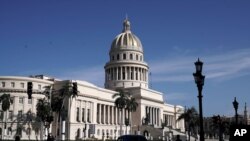Cuba is known for mammoth, officially sanctioned gatherings to celebrate the anniversary of the Cuban Revolution and May Day, while even very much smaller anti-government demonstrations like those Sunday are very rare on the tightly controlled island.
Some of the most significant protests:
Aug. 5-6, 1994: Thousands of Cubans take to the streets amid a severe economic crisis after the collapse of the Soviet Union, whose aid propped up Cuba's economy. President Fidel Castro shows up at one gathering, deterring the protesters.
2003: A group of wives and mothers of prisoners, known as the Ladies in White, demonstrate in front of a church in Havana after the government rounds up dissidents and sentences them to severe prison terms. The group stages rallies, with fluctuating numbers of participants and an irregular schedule, in various places until at least 2018.
May 2019: A demonstration by the LGBT community without the backing of official institutions ends in confrontation and arrests. Authorities call the rally a provocation.
November 2020: Artists, representing numerous approaches to art, gather in front of the Ministry of Culture to demand more space for independent creation.




